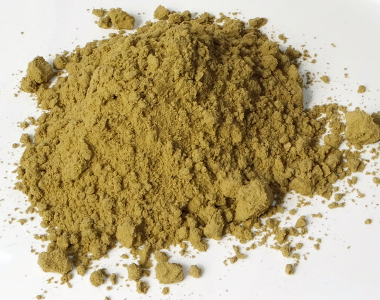Hemp Protein - Composition and Amino Acids

Hemp protein is obtained during the production of hemp oil. The hemp seeds are pressed, and a by-product called press cake is created. This press cake is then further processed into protein powder.
Hemp seeds alone contain 31.6 grams of protein per 100 grams, making them one of the best plant-based protein sources. They contain all nine essential amino acids in high amounts and have an excellent amino acid composition, making them a high-quality protein source.
Hemp protein is gluten-free 1.
High-Quality Protein Compounds in Hemp Seeds
Hemp seeds contain up to 181 different proteins 2 3. Proteins are composed of amino acids, which the body needs as building blocks for muscle cells, enabling muscle growth.
Edestin and albumin are the two main proteins (protein fractions) in hemp seeds. 4 5 6. These two high-quality storage proteins (reserve proteins) are characterized by significant amounts of all essential amino acids.
According to scientists, hemp proteins are a good source for a protein-rich diet. 7.
Protein Content in Hemp Protein Powder
The protein content in conventional hemp protein powder ranges from 40 to 52.27% and in hemp protein concentrate up to 90.53% 8 9 10 11. In a concentrate or isolate, the protein is isolated, which not only increases the protein content but also reduces the carbohydrate content.
High Arginine Content in Hemp Protein
Hemp protein contains very high levels of the amino acid arginine. This amino acid is converted into nitric oxide (NO) in the body's metabolism. Nitric oxide is a central neurotransmitter in the cardiovascular system (enables information exchange between nerve cells) 12. It is involved in regulatory functions such as the control of hemostasis (blood clotting) and fibrinolysis (dissolution of blood clots) 13. Thus, nitric oxide is needed, for example, for blood pressure and vascular tone regulation, leukocyte adhesion (adhesion of leukocytes), and inhibition of platelet aggregation (clumping of blood platelets) 14.
Thus, a diet rich in arginine may potentially reduce the risk of cardiovascular diseases 15 16.
In addition, hemp protein contains high levels of the amino acids methionine and cysteine.
Limiting Amino Acids
Limiting amino acids are the amino acids that are least abundant in a food or dietary source. They are taken into consideration when assessing protein quality. In the case of hemp protein, lysine is the limiting amino acid, followed by leucine and tryptophan 17. Therefore, hemp protein has lower amounts of these amino acids. Hence, hemp protein is considered an incomplete protein in scientific research 18. You can find a list of foods high in lysine here.
Furthermore, the PDCAAS value for hulled hemp seeds ranges from 0.63 to 0.66 19. Currently, no value can be found for hemp protein. The PDCAAS is used as a tool for comparing protein quality. The value indicates the amino acid profile and digestibility of the proteins, with a maximum value of 1.0.
Amino Acid Distribution
Percentage distribution of amino acid composition in hemp protein 20:
| Amino Acid | % |
|---|---|
| Aspartic Acid | 10.78 |
| Threonine | 3.75 |
| Serine | 5.65 |
| Glutamic Acid | 18.45 |
| Proline | 4.37 |
| Glycine | 4.67 |
| Alanine | 4.19 |
| Cysteine | 1.52 |
| Valine | 4.69 |
| Methionine | 2.28 |
| Isoleucine | 3.59 |
| Leucine | 6.87 |
| Tyrosine | 3.04 |
| Phenylalanine | 4.68 |
| Histidine | 3.26 |
| Lysine | 3.94 |
| Arginine | 13.20 |
| Tryptophan | 1.06 |
For the nutritional values of hemp protein, click here.
High Fiber Content
Hemp protein powder has a high content of insoluble fiber 21. Dietary fiber promotes a healthy digestive tract and can reduce the risk of heart disease 22.
The powder also contains omega-6 and omega-3 fatty acids as well as carbohydrates in small amounts.
Hemp proteins are easily digestible
Hemp proteins are known for their good digestibility 23 24. This allows the body to more efficiently utilize the consumed proteins.
Differences between Hemp Protein and Soy Protein
Compared to soy protein, hemp protein can be much more easily digested. With hemp protein isolate, 88 to 91% of the protein is digested, while with soy protein isolate, only 71% is digested 25.
In addition, hemp protein contains equal or higher levels of essential amino acids, except for lysine 26 27.
The PDCAAS value for soy protein is 1.0 28. For hemp protein, this value is lower due to the limiting amino acid lysine.
Side Effects - Unhealthy?
Hemp protein powder is a dietary supplement that does not replace a balanced diet. Like all dietary supplements, its intake should be tailored to individual physical needs and goals – see protein requirement, protein deficiency, and protein excess.
Due to its high fiber content, it can lead to loose stools 29.
To avoid possible side effects, start with low dosages and gradually increase them.
Single-Component and Multi-Component Protein Powders
Hemp protein is available both as a single-component protein powder and in combination with other plant-based protein sources as multi-component protein powder (blend).
Using Hemp Protein
Hemp protein can be used like other protein powders. Taste and texture (slightly sandy) may take some getting used to. It pairs well with its slightly nutty flavor in vegan protein shakes and smoothies. It is recommended to combine hemp protein with other vegan protein powders such as lupine protein, pea protein, and/or rice protein, mainly for taste reasons.
Additional uses include yogurt, cereal, protein bars, and pancakes.
Moreover, hemp protein is suitable as a baking ingredient for cakes, breads, muffins, and brownies.
 VEGANALYZE
VEGANALYZE